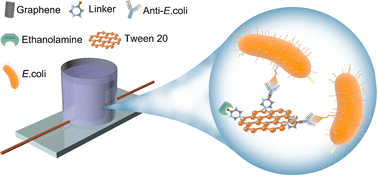Capture and detection of Escherichia coli with graphene aerogels†
Abstract
Some pathogenic bacteria may cause serious food poisoning as well as catastrophic infections. Thus, it is critical to identify bacteria using simple, quick, and sensitive methods. Herein, we fabricate a graphene aerogel-based biosensing system to capture and detect Escherichia coli (E. coli) with high specificity and sensitivity. A graphene aerogel is prepared by a one-step hydrothermal synthesis method without any reducing reagent. With the help of E. coli antibodies and the graphene foam with a porous structure, E. coli can be captured using the detection substrate with high specificity and selectivity. The electrical resistance and electrochemical impedance spectroscopy (EIS) results of the graphene aerogel foam changed with high sensitivity during E. coli adhesion. Moreover, the resistance change of the graphene device can still be observed when the E. coli concentration was as low as 10 cfu mL−1, while there is no obvious resistance change in the use of Staphylococcus aureus. The subsequent EIS test also found that the charge transfer resistance (Rct) of the detection substrate gradually increased during the E. coli capture process. This nanoelectronic biosensor is simple, quick, safe, and very sensitive, and it may be used as a high-throughput platform for pathogenic bacterial detection, bacterial research, and antimicrobial drug screening.



 Please wait while we load your content...
Please wait while we load your content...